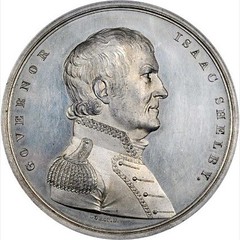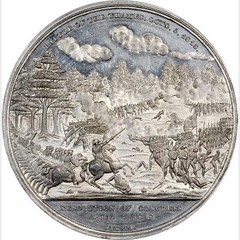
PREV ARTICLE
NEXT ARTICLE
FULL ISSUE
PREV FULL ISSUE
THE MEDALS OF ISAAC SHELBYDennis Tucker published a nice article by Robert W. Shippee on medals of Kentucky Governor Isaac Shelby. Here's a short excerpt and some images - see the complete article online. -Editor Moritz Fürst, a talented, if mercurial, engraver and die sinker, had the job of preparing many of the dies needed to strike the medals awarded to senior Army and Navy officers for their heroics in the War of 1812. Because of his work backlog, he did not finish preparing the dies used to strike the Shelby medal until May 1822. Fürst created the obverse die based on a portrait or sketch of Shelby but used a design prepared by the famous portrait painter Thomas Sully to sculpt the reverse die. The reverse of the Shelby medal depicts one of the most stunning battle scenes ever to appear on any early American military medal, rivaling the work of leading French medalist, Augustin Dupré, on the Daniel Morgan at Cowpens medal. Sully and Fürst made a point of showing the death of Tecumseh within the battle scene. The dies were turned over to the U.S. Mint in May 1822, as mentioned, but further delays ensued. The gold medal itself, measuring 65 mm in diameter (just over 2.5 inches), was not produced by the Mint until March 1824. It was then promptly presented to Shelby at his home in Kentucky, more than a decade after the battle and barely two years before his death. Shelby bequeathed his gold medal to his wife, who, in turn, left it to their son, Isaac Jr., upon her death in 1833. He (or perhaps a descendant of his) donated the medal to the Kentucky Historical Society several decades later. The medal was stolen from the KHS in the mid-1930s, and it is probably lost forever.
The medal pictured here is from the author's collection: one of a very small number of surviving white metal examples. The collaring mark or
To read the complete article, see:
Wayne Homren, Editor The Numismatic Bibliomania Society is a non-profit organization promoting numismatic literature. See our web site at coinbooks.org. To submit items for publication in The E-Sylum, write to the Editor at this address: whomren@gmail.com To subscribe go to: https://my.binhost.com/lists/listinfo/esylum All Rights Reserved. NBS Home Page Contact the NBS webmaster 
|


